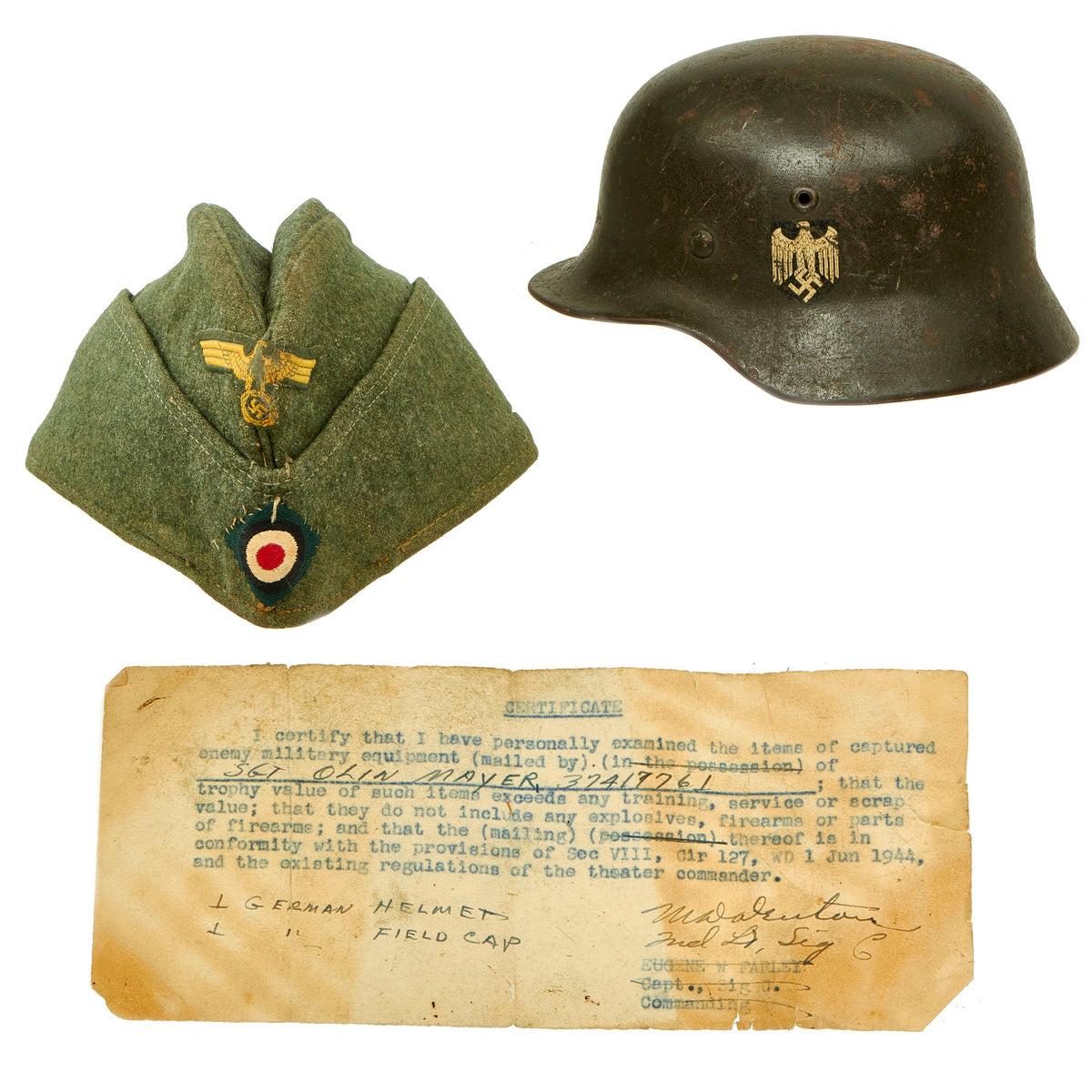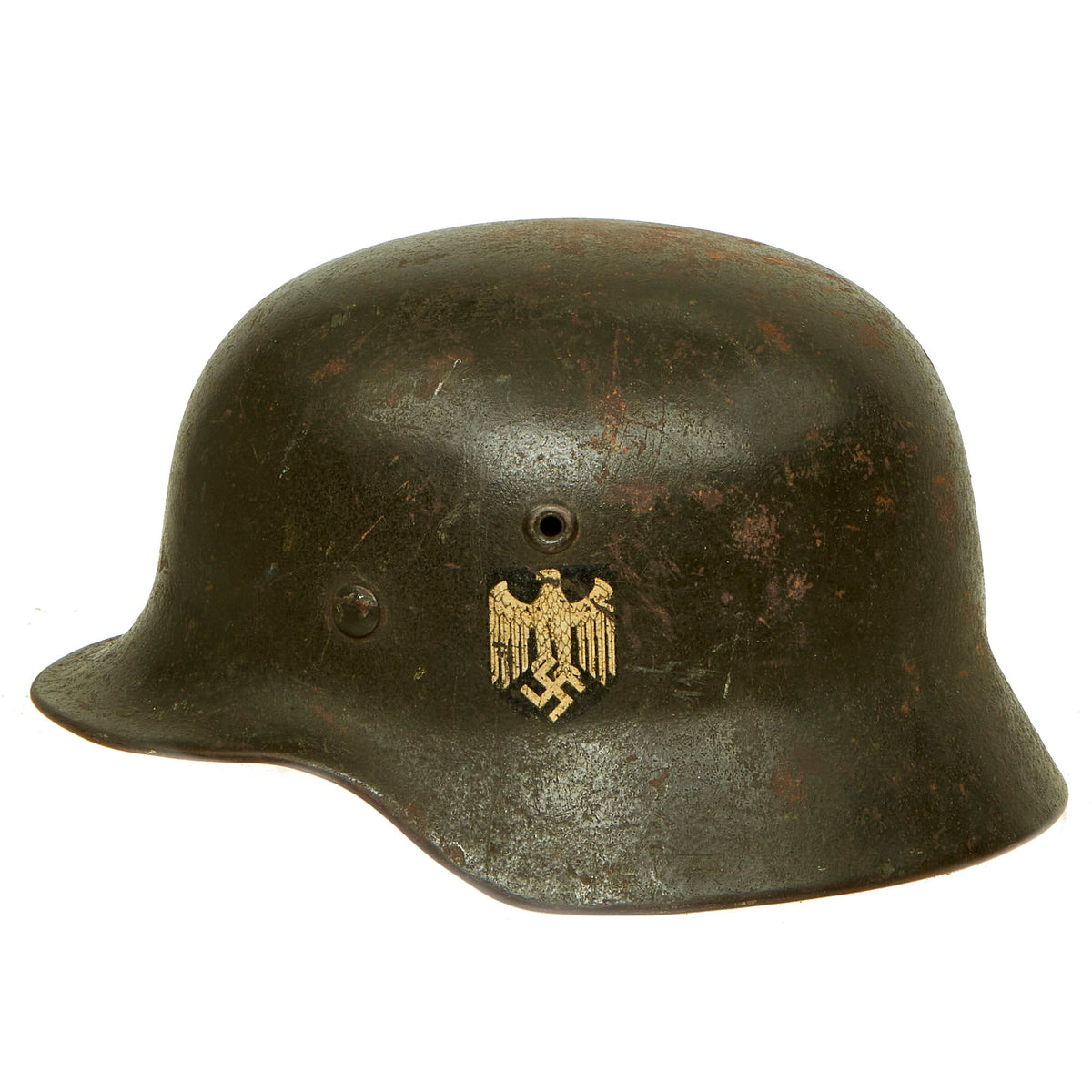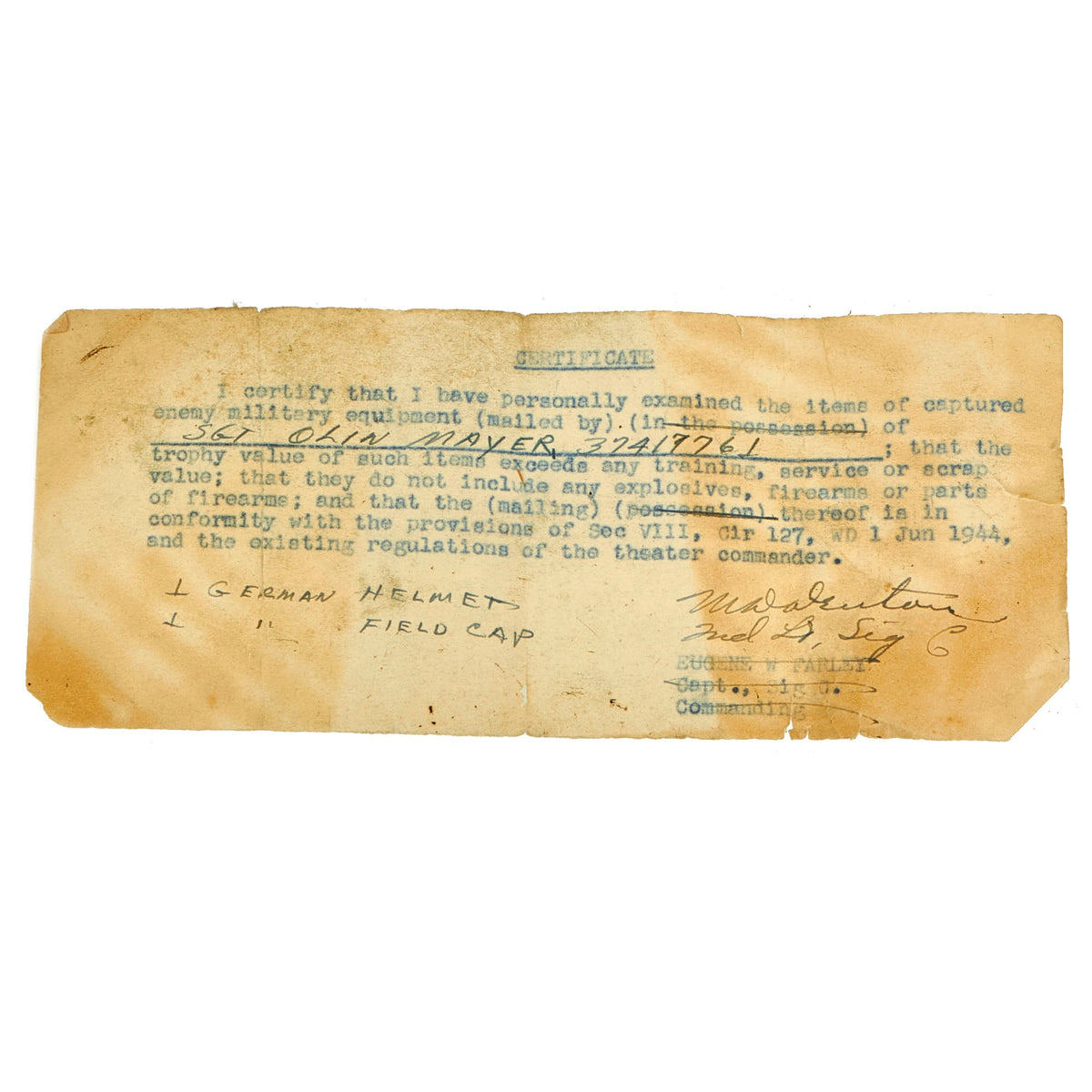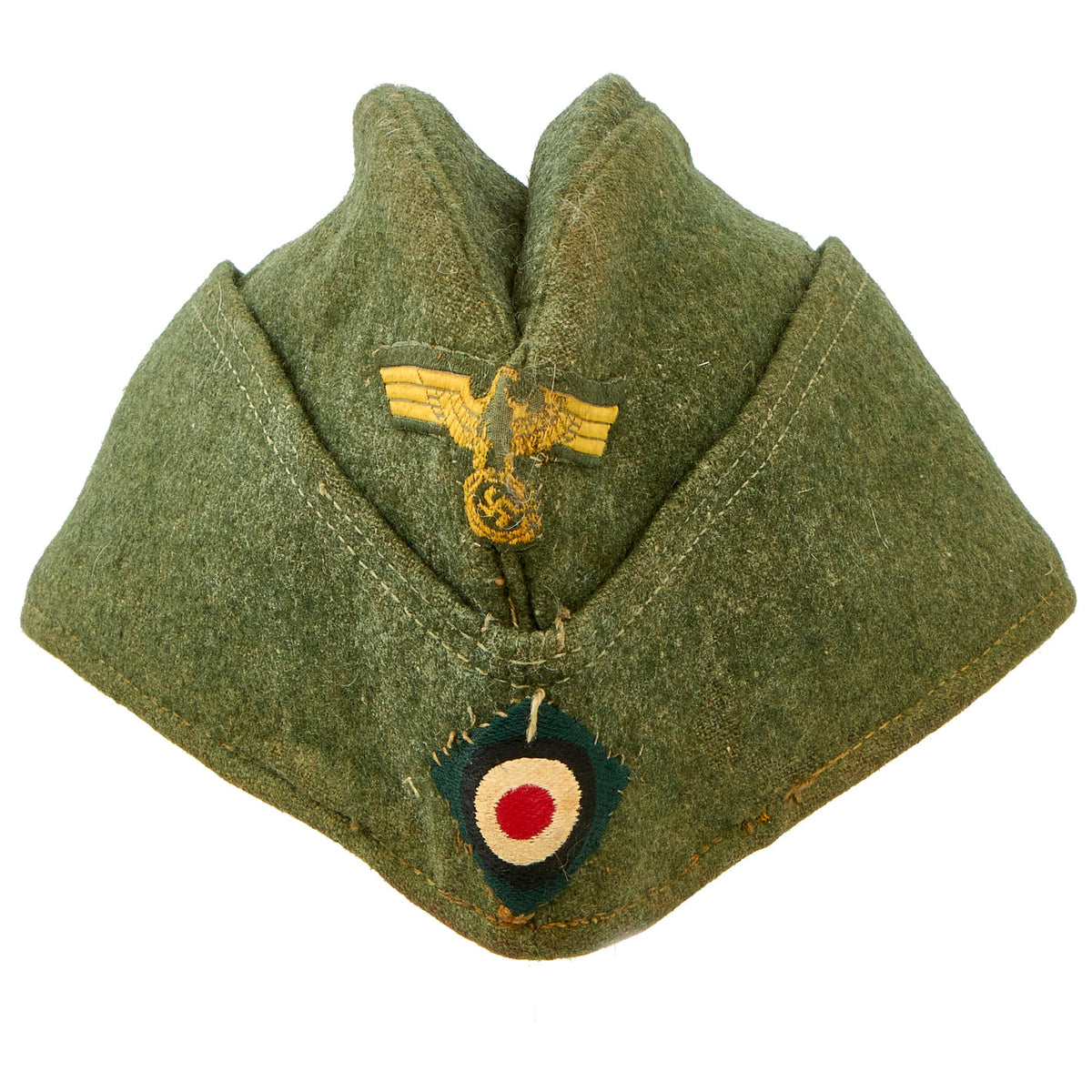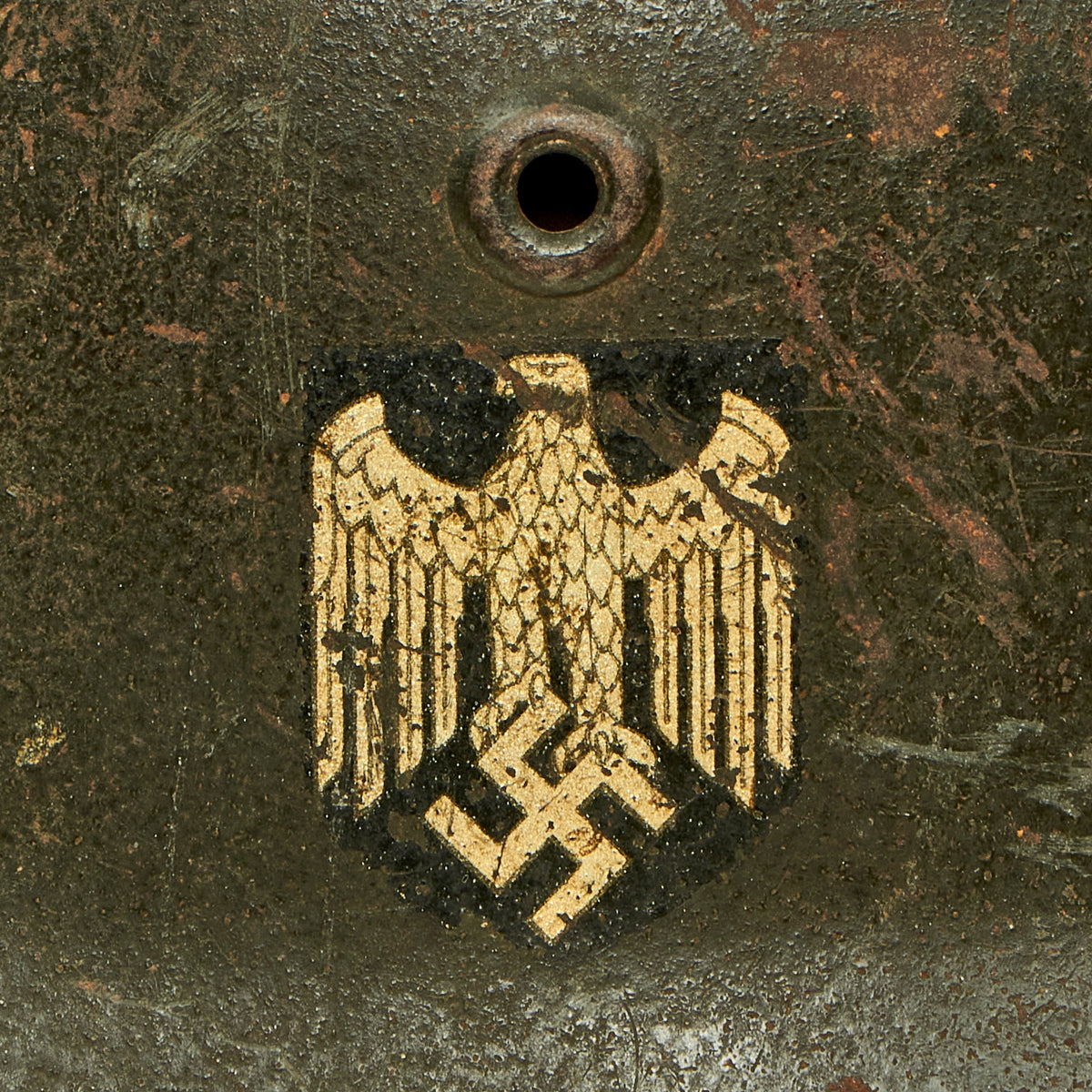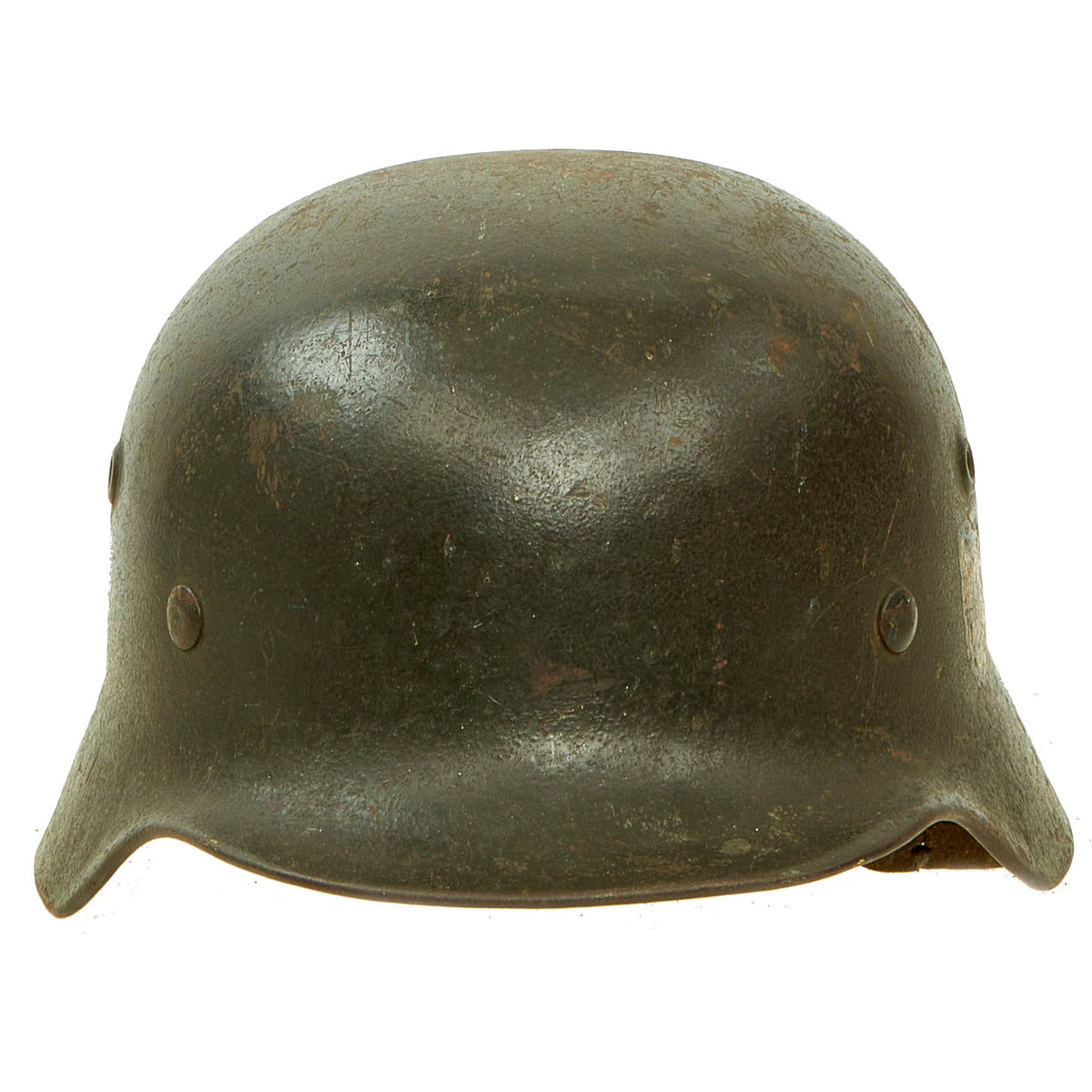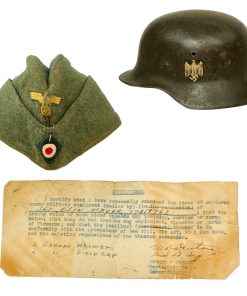Original German WWII Documented USGI Bring Back Set – Army Heer M40 Single Decal Helmet & Kriegsmarine Coastal Artillery M38 Cap Original Items
$ 1.495,00 $ 373,75
Original Item: One of a Kind Set. This is a fantastic USGI bring back grouping from the European theater of WWII. As the saying goes, “To the Victor, The Spoils”, so USGIs brought home large amounts of material from WWII Germany. It was however regulated, and items were supposed to be inspected to make sure they did not have any intelligence value and were also appropriate to send back. Live grenades were definitely NOT an item that was wanted on the voyage with returning GI’s.
This set comes with a “CERTIFICATE” named to SGT OLIN MAYER, 37417761, and indicates that the items were mailed back to the United States. It is signed by an official from “Sig G”, though we cannot read the signature, and the lines below are crossed out. The certificate indicates that the items have been checked and are all allowed to be brought back home, and lists the items as:
1 – GERMAN HELMET
1 – ” FIELD CAP
These are exactly the items that we have in this lovely grouping!
We also have found the enlistment records of Olin A. Mayer, which indicate that he was born in 1923, and was a resident of St. Charles, Missouri. He enlisted February 10, 1943 at the Jefferson Barracks in Missouri, and was listed as working assembling shoes. He enlisted as a private, so he was promoted to an NCO during the course of the war. We have not been able to find much about his life after the war, except that he was married and had three children. Definitely some great research potential.
The helmet in this set is a great all original example of a German Model 40 Steel helmet, as issued to the Wehrmacht Heer (army). This stamped sheet steel construction helmet retains about 75% of its original lightly textured panzergrau paint, with the usual scratches and chips from service, however it still looks great. The left side of the helmet features a wonderful Heer eagle decal, which is retained at about 80%, with the silver on the eagle still vibrant. There is just a bit of chipping to the decal, and it still reflects the light well.
The reverse, interior, neck guard apron is serial number stamped 9850 and the interior, left side, apron has the stamped manufacturer’s code and size, SE64 indicating that it was manufactured by Sächsische Emaillier und Stanzwerke A.G. of Lauter, Germany. Size 64 is a nice medium size that can accommodate liners from 56cm to 57cm or US 7 to 7 1/8. Size 64 shells are harder to find and are therefore more valuable to a collector.
All three liner split pins are still intact, and retain much of their original paint, which matches the color and texture of the shell perfectly. The helmet still has its correct M31 liner with all of the 8 fingers present, now matured to a lovely chestnut color with a bit of splitting over the edge. The original top tie is present and in very good shape. The liner band is the correct mid-war galvanized steel, and is marked on the left side with 64 n.A. / 56, indicating that it is a size 56 line for a size 64 shell. The liner band is very tight to the shell on the right side, so we cannot see the maker marking.
There is still an original chin strap attached to the rectangular loops, which is in supple but worn condition. There is a previous repaired gear through the longer portion, and it is in somewhat delicate condition.
The cap in this set very nice lightly used of a hard to find German WWII Kriegsmarine Coastal Artillery overseas cap (Küstenartillerie Schiffchen). The overseas cap, nicknamed in German military slang as Schiffchen, or literally “little ship” as it resembled an up-turned row-boat, was standard issue for the Coastal Artillery.
This example is constructed of a a field gray (feldgrau) wool exterior, with a nice light gray canvas liner. This is similar to the army colors, however it features a fine BeVO machine embroidered eagle, with yellow thread on a green base, the Kriegsmarine colors. Below this is a BeVO machine embroidered tri-color cockade, which is woven on blue green material. Both are sewn to the cap using identical thread. The inside of the cap is size marked 56, and there is a maker stamp which is unfortunately too faint to read, except for the date of 1941 at the bottom.
Condition of this cap is good, though there exterior does show some age toning and wear, especially on the eagle insignia. Under the side flaps the original color is still well retained. The interior shows a bit of yellowing but very little use. We can also see that there also was at one time a soutache of some type on the front, now removed.
A great USGI bring back set consisting of a great 100% genuine M40 Single Decal Heer Army helmet and a Kriegsmarine Coastal Artillery M38 Overseas cap, both with some lovely period wear. With the named award document, this is a set that will only continue to appreciate in value over time.
The German “Stahlhelm” Helmet
The first “modern” steel helmets were introduced by the French army in early 1915 and were shortly followed by the British army later that year. With plans on the drawing board, experimental helmets in the field, (“Gaede” helmet), and some captured French and British helmets the German army began tests for their own steel helmet at the Kummersdorf Proving Grounds in November, and in the field in December 1915. An acceptable pattern was developed and approved and production began at Eisen-und Hüttenwerke, AG Thale/Harz, (Iron and Foundry Works), in the spring of 1916.
These first modern M16 helmets evolved into the M18 helmets by the end of WWI. The M16 and M18 helmets remained in usage through-out the Weimar Reichswehr, (National Defence Force, Circa 1919-1933), era and on into the early years of the Third Reich until the development of the smaller, lighter M35 style helmet in June 1935.
In 1934 tests began on an improved Stahlhelm, whose design was a development of World War I models. The Eisenhüttenwerke company of Thale carried out prototype design and testing, with Dr. Friedrich Schwerd once again taking a hand.
The new helmet was pressed from sheets of molybdenum steel in several stages. The size of the flared visor and skirt was reduced, and the large projecting lugs for the obsolete armor shield were eliminated. The ventilator holes were retained, but were set in smaller hollow rivets mounted to the helmet’s shell. The edges of the shell were rolled over, creating a smooth edge along the helmet. Finally, a completely new leather suspension, or liner, was incorporated that greatly improved the helmet’s safety, adjustability, and comfort for each wearer. These improvements made the new M1935 helmet lighter, more compact, and more comfortable to wear than the previous designs.
The Army’s Supreme Command officially accepted the new helmet on June 25, 1935 and it was intended to replace all other helmets in service.
The M1935 design was slightly modified in 1940 to simplify its construction, the manufacturing process now incorporating more automated stamping methods. The principal change was to stamp the ventilator hole mounts directly onto the shell, rather than utilizing separate fittings. In other respects, the M1940 helmet was identical to the M1935. The Germans still referred to the M1940 as the M1935, while the M1940 designation were given by collectors.
The last wartime upgrade to the standard helmet took place on 6 July 1942 at the request of the Army High Command. The rolled edge found on M1935 and M1940 helmets was discontinued as a measure of economy. On 1 August 1942 the first M1942 helmets were placed into production, and this was the model produced until late in the war, when most factories were captured or stood idle due to material shortages.
Fast Shipping with Professional Packaging
Thanks to our longstanding association with UPS FedEx DHL, and other major international carriers, we are able to provide a range of shipping options. Our warehouse staff is expertly trained and will wrap your products according to our exact and precise specifications. Prior to shipping, your goods will be thoroughly examined and securely secured. We ship to thousands clients each day across multiple countries. This shows how we're dedicated to be the largest retailer on the internet. Warehouses and distribution centres can be located throughout Europe as well as the USA.
Note: Orders with more than one item will be assigned a processing date depending on the item.
Before shipping before shipping, we'll conduct a thorough inspection of the items you have ordered. Today, the majority of orders will be delivered within 48 hours. The delivery time will be between 3-7 days.
Returns
The stock is dynamic and we cannot completely manage it because multiple stakeholders are involved, including our factory and warehouse. So the actual stock may alter at any time. It's possible that you may not receive your order once the order has been made.
Our policy is valid for a period of 30 days. If you don't receive the product within 30 days, we are not able to issue a refund or an exchange.
You can only return an item if it is unused and in the same state as the day you received it. You must have the item in its original packaging.
Related products
Uncategorized
Uncategorized
Uncategorized
Uncategorized
Uncategorized
Uncategorized
Uncategorized
Armored Burgonet Helmet & Polearm from Scottish Castle Leith Hall Circa 1700 Original Items
Uncategorized
Uncategorized
Uncategorized
Uncategorized
Uncategorized
Uncategorized
Uncategorized
Uncategorized
Uncategorized
Uncategorized
Uncategorized
Australian WWII Owen MK1 Machine Carbine SMG Custom Fabricated Replica with Sling Original Items
Uncategorized
Uncategorized
Angolan Rebel 1970s era 60mm Inert Display Mortar from Angolan Civil War Original Items
Uncategorized
